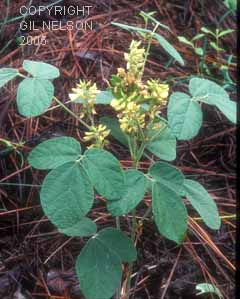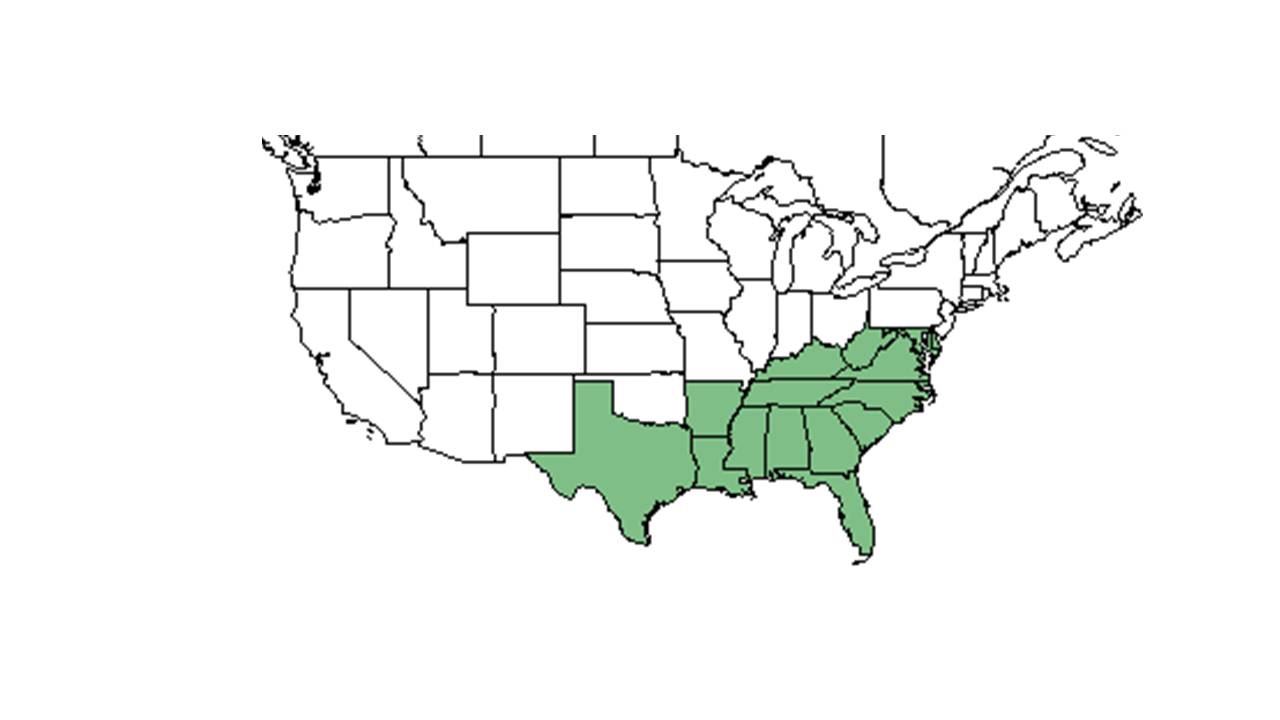Difference between revisions of "Rhynchosia tomentosa"
(Created page with "{{italic title}} <!-- Get the taxonomy information from the NRCS Plants database --> {{taxobox | name = Rhynchosia tomentosa | image = Rhynchosia tomentosa_Gil.jpg | image_cap...") |
|||
| Line 19: | Line 19: | ||
==Description== | ==Description== | ||
<!-- Basic life history facts such as annual/perrenial, monoecious/dioecious, root morphology, seed type, etc. --> | <!-- Basic life history facts such as annual/perrenial, monoecious/dioecious, root morphology, seed type, etc. --> | ||
| + | Common name is Twining snoutbean (Nelson 2005). | ||
==Distribution== | ==Distribution== | ||
| + | ''R. tomentosa'' was found in the study area “within the Upper Coastal Plain Ecoregion with nearly level to gently rolling topography and a maximum elevation of 240m.” (Archer et al 2007). | ||
==Ecology== | ==Ecology== | ||
===Habitat=== <!--Natural communities, human disturbed habitats, topography, hydrology, soils, light, fire regime requirements for removal of competition, etc.--> | ===Habitat=== <!--Natural communities, human disturbed habitats, topography, hydrology, soils, light, fire regime requirements for removal of competition, etc.--> | ||
| + | Found in sandhills, edge of hammocks, mixed pine and hardwood forests, savannas, and flatwoods (Nelson 2005). | ||
===Phenology=== <!--Timing off flowering, fruiting, seed dispersal, and environmental triggers. Cite PanFlora website if appropriate: http://www.gilnelson.com/PanFlora/ --> | ===Phenology=== <!--Timing off flowering, fruiting, seed dispersal, and environmental triggers. Cite PanFlora website if appropriate: http://www.gilnelson.com/PanFlora/ --> | ||
| + | Blooms from May to June (Nelson 2005). | ||
===Seed dispersal=== | ===Seed dispersal=== | ||
===Seed bank and germination=== | ===Seed bank and germination=== | ||
===Fire ecology=== <!--Fire tolerance, fire dependence, adaptive fire responses--> | ===Fire ecology=== <!--Fire tolerance, fire dependence, adaptive fire responses--> | ||
| + | Was observed as an understory plant from frequently burned old-growth mountain longleaf pine stands at Fort McClellan, Alabama (Varner et al 2003). | ||
===Pollination=== | ===Pollination=== | ||
===Use by animals=== <!--Herbivory, granivory, insect hosting, etc.--> | ===Use by animals=== <!--Herbivory, granivory, insect hosting, etc.--> | ||
| Line 31: | Line 36: | ||
==Conservation and Management== | ==Conservation and Management== | ||
==Cultivation and restoration== | ==Cultivation and restoration== | ||
| + | R. tomentosa was found to be an indicator species in areas 30-80 years after clear-cutting in a southeastern mixed pine forest (Archer et al. 2007). | ||
==References and notes== | ==References and notes== | ||
==Photo Gallery== | ==Photo Gallery== | ||
Revision as of 10:40, 17 June 2015
| Rhynchosia tomentosa | |
|---|---|

| |
| Photo taken by Gil Nelson | |
| Scientific classification | |
| Kingdom: | Plantae |
| Division: | Magnoliophyta – Flowering plants |
| Class: | Magnoliopsida – Dicotyledons |
| Order: | Fabales |
| Family: | Fabaceae ⁄ Leguminosae |
| Genus: | Rhynchosia |
| Species: | R. tomentosa |
| Binomial name | |
| Rhynchosia tomentosa (L.) Hook. & Arn. | |

| |
| Natural range of Rhynchosia tomentosa from USDA NRCS Plants Database. | |
Contents
Description
Common name is Twining snoutbean (Nelson 2005).
Distribution
R. tomentosa was found in the study area “within the Upper Coastal Plain Ecoregion with nearly level to gently rolling topography and a maximum elevation of 240m.” (Archer et al 2007).
Ecology
Habitat
Found in sandhills, edge of hammocks, mixed pine and hardwood forests, savannas, and flatwoods (Nelson 2005).
Phenology
Blooms from May to June (Nelson 2005).
Seed dispersal
Seed bank and germination
Fire ecology
Was observed as an understory plant from frequently burned old-growth mountain longleaf pine stands at Fort McClellan, Alabama (Varner et al 2003).
Pollination
Use by animals
Diseases and parasites
Conservation and Management
Cultivation and restoration
R. tomentosa was found to be an indicator species in areas 30-80 years after clear-cutting in a southeastern mixed pine forest (Archer et al. 2007).